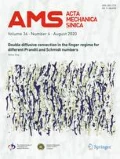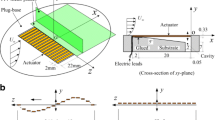Abstract
The spatial relations between the measurable wall quantities (streamwise shear stress \(\tau _{\mathrm{w}{ x}}\), spanwise shear stress \(\tau _{\mathrm{w}{ z}}\), and pressure fluctuations \(p^\prime _\mathrm{w}\)) and the near-wall streamwise vortices (NWSV) are investigated via direct numerical simulation (DNS) databases of fully developed turbulent channel flow at a low Reynolds number. In the standard turbulent channel flow, the results show that all the wall measurable variables are closely associated with the NWSV. But after applying a stochastic interference, the relation based on \(\tau _{\mathrm{w}{ x}}\) breaks down while the correlations based on \(p^\prime _\mathrm{w}\) and \(\tau _{\mathrm{w}{ z}}\) are still robust. Hence, two wall flow quantities based on \(p^\prime _\mathrm{w}\) and \(\tau _{\mathrm{w}{ z}}\) are proposed to detect the NWSV. As an application, two new control schemes are developed to suppress the near-wall vortical structures using the actuation of wall blowing/suction and obtain 16 % and 11 % drag reduction, respectively.
Graphical abstract
The deformation and typical force curve of the mosquito leg when it is pressed onto a water surface.


















Similar content being viewed by others
References
Kim, J.: Physics and control of wall turbulence for drag reduction. Philos. Trans. R. Soc. A 2011, 1396–1411 (1940)
Viswanath, P.R.: Aircraft viscous drag reduction using riblets. Prog. Aerosp. Sci. 38, 571–600 (2002)
Ceccio, S.L.: Friction drag reduction of external flows with bubble and gas injection. Annu. Rev. Fluid Mech. 42, 183–203 (2010)
Guan, X.L., Yao, S.Y., Jiang, N.: A study on coherent structures and drag-reduction in the wall turbulence with polymer additives by TRPIV. Acta Mech. Sin. 29, 485–493 (2013)
Bewley, T.R., Moin, P., Temam, R.: DNS-based predictive control of turbulence: an optimal benchmark for feedback algorithms. J. Fluid Mech. 447, 179–225 (2001)
Högberg, M., Bewley, T.R., Henningson, D.S.: Relaminarization of \(\mathit{Re}_\tau = 100\) turbulence using gain scheduling and linear state-feedback control. Phys. Fluids 15, 3572–3575 (2003). (1994-present)
Choi, H., Moin, P., Kim, J.: Active turbulence control for drag reduction in wall-bounded flows. J. Fluid Mech. 262, 75–110 (1994)
Lee, C., Kim, J., Choi, H.: Suboptimal control of turbulent channel flow for drag reduction. J. Fluid Mech. 358, 245–258 (1998)
Xu, C.X., Choi, J.I., Sung, H.J.: Suboptimal control for drag reduction in turbulent pipe flow. Fluid Dyn. Res. 30, 217 (2002)
Fukagata, K., Kasagi, N.: Suboptimal turbulence control algorithm for the modification of Reynolds stress in the near-wall layer. In: Proceedings of the 4th International Symposium on Smart Control of Turbulence, pp. 123–130. Tokyo, Japan (2003)
Lee, C., Kim, J., Babcock, D., et al.: Application of neural networks to turbulence control for drag reduction. Phys. Fluids 9, 1740–1747 (1997)
Gad-el-Hak, M.: The taming of the shrew: why is it so difficult to control turbulence? Active flow control. Berlin Heidelberg, Springer (2007)
Kasagi, N., Suzuki, Y., Fukagata, K.: Microelectromechanical systems-based feedback control of turbulence for skin friction reduction. Annu. Rev. Fluid Mech. 41, 231–251 (2009)
Cattafesta III, L.N., Sheplak, M.: Actuators for active flow control. Annu. Rev. Fluid Mech. 43, 247–272 (2011)
Yoshino, T., Suzuki, Y., Kasagi, N.: Drag reduction of turbulence air channel flow with distributed micro sensors and actuators. J. Fluid Sci. Technol. 3, 137–148 (2008)
Kravchenko, A.G., Choi, H., Moin, P.: On the relation of near-wall streamwise vortices to wall skin friction in turbulent boundary layers. Phys. Fluids A 5, 3307–3309 (1993)
Kim, J., Choi, J.I., Sung, H.J.: Relationship between wall pressure fluctuations and streamwise vortices in a turbulent boundary layer. Phys. Fluids 14, 898–901 (2002)
Xu, C., Zhang, Z., Nieuwstadt, F.T.M., et al.: Origin of high kurtosis levels in the viscous sublayer. Direct Numer. Simul Exp. Phys. Fluids 8, 1938–1944 (1996)
Ge, M.W., Xu, C.X., Cui, G.X.: Transient response of Reynolds stress transport to opposition control in turbulent channel flow. Sci. China Phys. Mech. Astron. 54, 320–328 (2011)
Ge, M., Xu, C., Huang, W., et al.: Transient response of enstrophy transport to opposition control in turbulent channel flow. Appl. Math. Mech. 34, 127–138 (2013)
Deng, B.Q., Xu, C.X.: Influence of active control on STG-based generation of streamwise vortices in near-wall turbulence. J. Fluid Mech. 710, 234–259 (2012)
Deng, B.Q., Xu, C.X., Huang, W.X., et al.: Strengthened opposition control for skin-friction reduction in wall-bounded turbulent flows. J. Turbul. 15, 122–143 (2014)
Fang, L., Shao, L., Bertoglio, J.P., et al.: The rapid-slow decomposition of the subgrid flux in inhomogeneous scalar turbulence. J. Turbul. 12, 1–23 (2011)
Fang, L., Shao, L., Bertoglio, J.P., et al.: An improved velocity increment model based on Kolmogorov equation of filtered velocity. Phys. Fluids 21, 065108 (2009)
Kim, J., Moin, P., Moser, R.: Turbulence statistics in fully developed channel flow at low Reynolds number. J. Fluid Mech. 177, 133–166 (1987)
Acknowledgments
The project was supported by the National Natural Science Foundation of China (Nos. 11402088 and 51376062), the Fundamental Research Funds for the Central Universities (No. 2014MS33) and State Key Laboratory of Alternate Electrical Power System with Renewable Energy Sources (No. LAPS15005).
Author information
Authors and Affiliations
Corresponding author
Rights and permissions
About this article
Cite this article
Ge, M., Xu, C. & Cui, GX. Active control of turbulence for drag reduction based on the detection of near-wall streamwise vortices by wall information. Acta Mech. Sin. 31, 512–522 (2015). https://doi.org/10.1007/s10409-015-0427-4
Received:
Revised:
Accepted:
Published:
Issue Date:
DOI: https://doi.org/10.1007/s10409-015-0427-4




